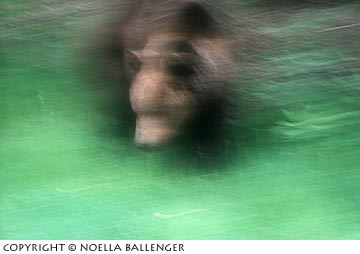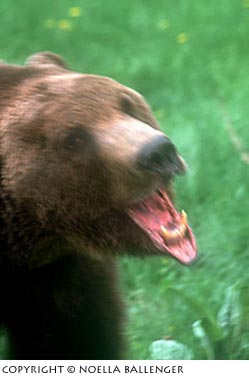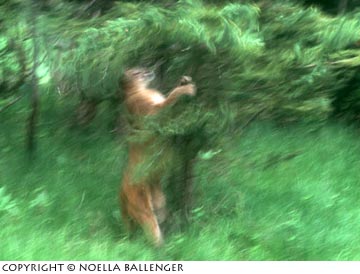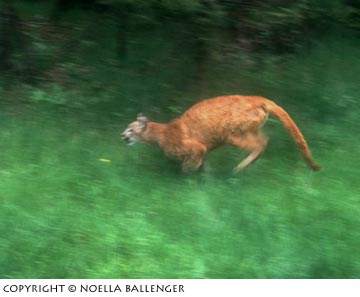
This is an image that I like because of the definite direction and blurring around the bear. Perhaps my imagination takes over and I can feel the tension in the bear’s action.
Not long ago, I picked up a magazine called DANCE International (Spring/Summer 2002). The featured article was an interview with photographer Lois Greenfield. I had seen her fabulous dance images before and wondered how they were taken. I remember viewing an exhibit by Howard Schatz called “Water Dance,” and those images were spectacular, as well. So, I knew I would enjoy the Lois Greenfield article.
In the interview, Greenfield was asked how she kept her work fresh and creative. ” ‘By not knowing what I’m going to do…And by being open to whatever happens. I can start with an idea and if it works, it works. If it doesn’t, we drop it and move on to something else. I’m fascinated by photographing the human body in motion. There is no right or wrong moment. Every moment conveys a different aspect of emotion. The most interesting moments are the ambiguous ones when you really don’t know what is happening or why.’ ”
Her comments started me thinking about some images I recently took, plus the ones I took during the US National Figure Skating events this past January (see “Just for Fun” Apogee article). I’ve been occupied the last several years with photographing animals. My excursions and workshops with Triple D Game Farm (see Apogee article “They stole my Heart”) have given me a portfolio of wonderful animal shots. When I was in Montana to photograph wild animal babies and their moms this spring, I decided to spend some of my time shooting with an aperture preferred setting that would allow the movement of the animal as well as my own movement to create some interesting effects. I chose aperture preferred, because–although I wanted the motion–I also hoped to get a strong focal point.

I am not sure about this one. I wanted some movement of the bear but I don’t think this is enough. The action isn’t different enough to carry the impact … it almost looks like an accident and not a deliberate.
In my mind, I set up an experimental scenario for this motion assignment and myself. (When you’re beginning a new process, it’s a good idea to write out the steps.) I’ve found that the way I learn best is to set up experiments. They always begin with the question, “What if I tried …?”
In my book, Nature by Design, I set up an experiment for you to do to illustrate the methods I use when I’m learning a new skill or asking a new question. See if you can do the same for whatever question you have. The following is a page out of my book that I want to share with you to help you to understand how I set up my “in-motion experiment”:
Experiment: Animals in motion
1. Find a location to suit your experiment.
Triple D Game Farm locations and their animals.
2. Ask the questions . . . What am I trying to do? How can I do it?
A. How can I capture the feeling of a wild animal running in a more artistic way?
B. If I set the aperture and let the camera select the shutter speed, I’ll resist the temptation to freeze the action. I want to have uncontrolled movement and still keep my exposures right on.
C. I’ll need to do this experiment while I’m simultaneously working on documenting the animal behavior and doing “straight” shots. (I think I’ll feel like an out-of-control juggler.)
3. Select the lens you want to use.
The lens I’ll use will be a zoom lens (35-300mm). I won’t have time to change lenses.
4. Decide on the ASA/ISO you will use and set the camera.
My camera is set to 100 ISO because I want to show motion. If I wanted to stop the action I would set it to 400 ISO.

This is exactly what I was going for. I love the feeling of the tree moving. It shows the power of the mountain lion. The shading among the variety of greens is artistic as well. The figure is clearly a mountain lion and you can see the strength in the paws as it grips the tree. Definitely pleased with the outcome of this one. It will be hanging on my wall soon.
5. Put your camera on a tripod.
For this experiment, I want to take my camera off the tripod and just let the action (the animal’s and my own) happen.
6. Begin the experiment.
The animals are here. I need to stay alert and follow the action. Panning is okay, as well as letting the animal run through the frame. THINK AND RESPOND TO WHAT YOU SEE AND FEEL.
7. Take frame one. Take notes.
No time to take notes. Just keep your fingers crossed and your eyes on what you’re seeing. Try to remember, so that later you can write it down–as soon as the session is over.
8. Change the settings, take a photograph, and take notes.
I continue to shoot, changing the aperture to vary the amount of motion I desire. I don’t have time for notes, but I’ll try to remember.
9. Change lenses.
Thank goodness for zoom lenses!
10. Redo the experiment and take notes.
I continue shooting, trying to remember all that I’m doing as well as all that I want to do.
11. Continue until you’ve finished the experiment.
I continue the experiment using all of my lenses from wide-angle to telephoto.
12. Review the images along with the notes.

The side fur of the lion is steady and all else of the cat is in motion. I love the circular pattern of movement on the rear quarters. For most of us, if we were to see a mountain lion in the wild, this is the kind of action we would probably see. It is gone almost before you realize it was here.
13. Summarize what you’ve learned. Make your own personal textbook using yournotes and photographs.
I learned that it’s sometimes difficult to stay alert and on top of the action. My images are delightful experiments, but I’m not sure that I would do as much of this as I did, the next time. Some of the images are really special–at least to me. Not everyone will enjoy the blurs and motion. I’ll create my own personal photo textbook with this information and my photographs. Perhaps I can use this experiment and new knowledge at a later time and in different circumstances.
14. Repeat the procedure as often as necessary with any concept you’re learning.
This experiment wasn’t so difficult to do. I can do it with other concepts, too. I just need to define the questions carefully and answer them by working the experiment systematically. I can do it!
Expanding your horizons, taking a chance on “failing” and having a “what if I tried…” mindset are all parts of the creative/exploring process that I’ve frequently written about. In an attempt to expand your horizons, I want to share some of my in-motion shots with you. And, I want to encourage you to try something new–something you haven’t tried before. Set up your own experiments. It’s amazing how much you can learn from such an adventure.

This is what I had been looking for in having a strong focal point (the face) without motion and all of the rest of the animal in motion. There is a richness in seeing movement in a still photograph. I don’t know if I captured it best in this one or in the Mountain Lion shaking the tree but I did come very close to what I was trying to do.
by Noella Ballenger

Leave a Reply